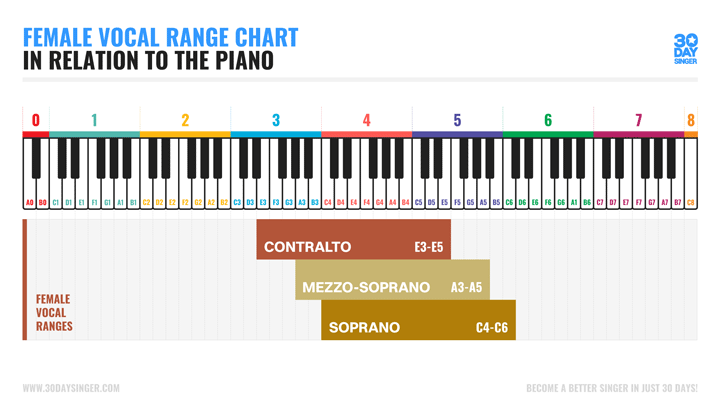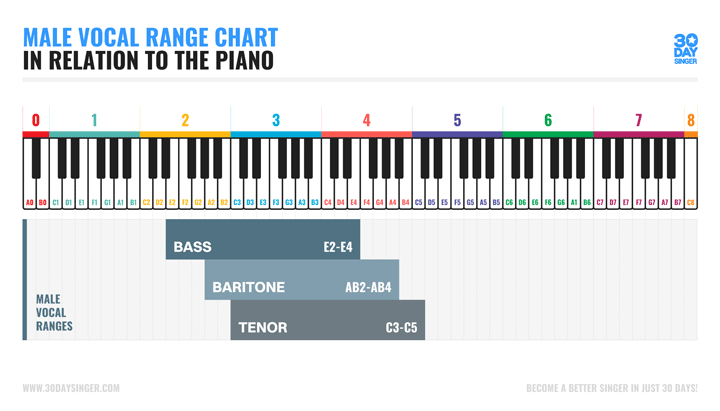How To Find Your Vocal Range
April 4, 2023
By Camille van Niekerk
Vocal ranges are basically the spectrum of notes that a person can sing, from the lowest to the highest.
Think of it as your singer playground.
Everyone's got a unique range, like a fingerprint for your voice.
This range gets split into categories based on pitch.
Knowing your vocal range is super handy because it helps you figure out what songs suit your voice best and how to sing them without sounding like you're straining to reach high notes or mumbling low notes.
It's all about finding that sweet spot where your voice feels comfortable and sounds great.
In this article, you’ll learn what the common vocal ranges are, how to find your range, and why it matters!
What are the common vocal ranges?

If you are curious how to know your vocal range, the best way start is by using a voice range chart.
The vocal range chart from highest to lowest notes above clearly shows the span of pitches that each individual range can confortably sing.
From highest to lowest, the 6 “standard” solo vocal ranges are:
Soprano: C4-C6
Mezzo-soprano: A3-A5
Contralto: E3-E5
Tenor: C3-C5
Baritone: Ab3-Ab4
Bass: E2-E4
The exact pitches may vary slightly, but these general ranges are widely accepted.
It's always a good idea to take a look at a vocal range chart when first learning about ranges.
We can split this out even further with a female vocal range chart.

Typical female vocal ranges go from the lowest being contralto to highest being soprano.
Typically most females are somewhere in between, in the mezzo-soprano vocal range.
Here is a male vocal range chart.
 Male vocal ranges include Bass, Baritone and Tenor.
Male vocal ranges include Bass, Baritone and Tenor.
When you hear male vocalists with high voices, they typically aren't going beyond the Tenor range.
Can’t a soprano sing lower than C4? And can’t a baritone sing higher than Ab4?
Yes! These ranges refer to a vocal part, not a specific singer.
You may have a wide range that covers more than one of the “standard” ranges.
Let’s say, for example, that you can sing from E3-A5.
Does that put you in the alto range, or mezzo-soprano?
Answering that question has less to do with range and more to do with tessitura.
What is tessitura?
Tessitura is the range in which you feel most comfortable and sound your best.
(Tessitura can also refer to the range of a melody within a specific piece of music).
When you see vocal ranges listed, understand them as the tessitura for a given vocal part, not the overall range.
So while most singers with a soprano range can (and do) sing lower than C4, their comfort and tone quality may begin to diminish in that range.
For that reason, they may choose to sing soprano repertoire, because that’s where they feel and sound their best.
But that doesn’t mean they can’t sing lower songs, or work on their low range.
How to find my vocal range?
You can find your vocal range in a few easy steps.
All you'll need is a chromatic tuner that can pick up the notes you sing.
Also, consult the voice ranges chart above for guidance as you go.
Firstly, find your lowest comfortable note to sing.
Starting in chest voice, sing a 'hum' and lower it in pitch as much as you comfortably can without loosing a pure tone.
Key word here: comfortable.
Sing that 'hum' into your chromatic tuner and write down what note the tuner shows.
Next, we'll do the same process to find your highest comfortable note to sing.
Starting in head voice, sing a 'hum' and gradually go up in pitch.
Make sure you can sing your highest note comfortably, no cracking or straining!
Sing that 'hum' into your chromatic tuner and write down that note as well.
There you have it, your vocal range!
Remember, check the singing ranges chart and follow along on your piano to make it as clear as possible.
How do I determine my vocal part?
Ask yourself: where do I feel most comfortable singing?
In what range do I sound my best?
Is there a specific range in which my voice “opens up”, sounding stronger and more brilliant?
These are questions you can’t answer in a few minutes, and you probably can’t answer fully at the very beginning of your training.
When should I choose a part?
If you’re singing contemporary music or learning to sing for fun, you don’t need to choose a part, at least not right away.
Most contemporary music isn’t written for specific vocal parts; rather, songs are written by (and for) individual artists, who often don’t fall neatly into one vocal part.
Some circumstances in which you may need to choose a voice part include:
-Singing in a choir
-Looking for range-specific vocal warm ups
-Finding repertoire for auditions
If you find yourself in one of the above situations, choose the part whose range corresponds most closely with your tessitura (the most comfortable, beautiful part of your range).
What if my range (or tessitura) is very narrow?
That’s normal, especially if you’re untrained or new to singing lessons!
The majority of untrained singers are most comfortable in their chest voice (speaking voice) range, since that’s the “mode” they use the most.
But that range is limited.
One of the first steps in vocal lessons is learning to access the other “modes” or “registers” of the voice, including your head voice or falsetto function, which is useful for accessing your highest pitches (much higher than chest or speaking function can produce).
Thankfully, there are plenty of songs you can sing within your specific vocal range:
Remember that most voices won’t fall neatly into one vocal range, and your range (along with your tessitura) is likely to change as you age and train your voice.
Understand where you’re comfortable today, but be open to change.
Vocal ranges are more than just labels; they help define the unique characteristics and strengths of a singer's voice.
Whether you're a sky-high soprano or a deep-voiced bass, your vocal range is like your musical fingerprint - totally unique to you.
Once you know your vocal range from its highest to its lowest notes you'll be able to start expanding those highs and lows how you see fit.
Understanding and embracing your range can unlock a whole world of musical expression and make singing all the more fun and fulfilling.
So go ahead, and use the singing ranges chart above to explore your range and let your voice shine in its own special way!
FAQ
What is the highest singing voice range?
The highest singing voice range is the soprano for women. In men, the highest range is the countertenor. These singers can hit those really high notes that seem to float above everything else.
What singer can sing 7 octaves?
The singer with a claim to a 7-octave range is Tim Storms. He's known for his incredibly wide range, but remember, this is super rare and quite extraordinary!
Who can hit 10 octaves?
Hitting 10 octaves sounds more like a myth than reality. There's no verified singer who can span 10 octaves. That's like, superhero-level singing!
Who has the rarest voice?
The rarest voice type would likely be the true contralto in women and the countertenor in men. These voice types are pretty unique and don't come around very often.
How To Know My Vocal Range?
Start with this post! Use the super handy vocal range chart above, then use a piano and go chromatically from your lowest comfortible note to your highest. Make sure the notes are comfortible to sing!

